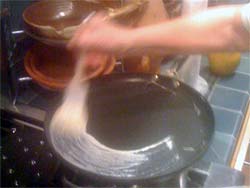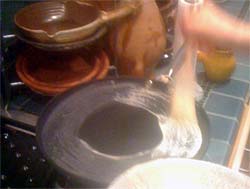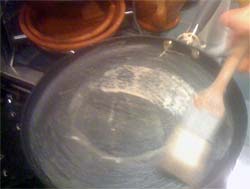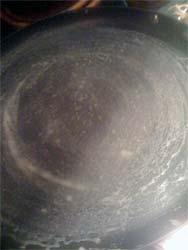
The making of warka, the paper-thin pastry leaves used in the famous Moroccan briks, pastillas, and other recipes, is always performed by specialists. It’s wonderful to watch these women as they knead a ball of dough then tap it multiple times on a metal pan heated over a charcoal brazier, creating a paper-thin leaf dab by dab. It’s a time consuming process, difficult to master and for this reason most recipes (including mine) recommend the use of commercial phyllo dough or commercial brick pastry.
However, good as phyllo and commercial brick pastry are, they are not the same as warka, neither as thin nor as tender.
Well, thanks to the internet, I learned a new and fairly easy way to make the pastry, by using a brush to apply liquid dough to a skillet at a constant temperature. The resulting warka is superb---more tender, crisper and more flavorful than anything commercial, a way to duplicate the otherwise inimitable quality of great Moroccan pastry dishes.
I owe special thanks to Chef Mourad Lahlou of the wonderful San Francisco restaurant, Aziza, for urging me to use very high gluten flour in my dough formula, (see note below).
To duplicate the constant (195 to 200 degree F) heat source of a Moroccan copper and tin warka pan heated over charcoal, I make my leaves in a non-stick skillet snuggly fitted over a pasta pot of boiling water, which I fasten the handles with string for stability.
The recipe below makes 15 to 18 10- to 12- inch warka leaves, more than enough for a twelve-inch pastilla. You can freeze the remaining sheets or use them to make hors d’oeuvres.
Freshly made warka sheets will keep in the refrigerator for up to 3 days. By tradition, these sheets are cooked on one side only and used, cooked (shiny) side out, when filled and fried or baked.
When using the warka leaves, remember that the shiny side, the cooked side, is always facing the frying oil, the baking dish or the heat of the oven.
It takes about 5 minutes to make this batter in a food processor and with practice about 2 minutes to make each leaf.
|
|
1. To prepare the batter: Combine the two flours and salt in the work bowl of a food processor. Turn the machine on and off once to sift. With the machine on, add almost l cup of the water and the vinegar. Once the dough forms a smooth ball, add the oil through the tube. Process the dough for 30 seconds. With the machine still running, slowly pour in the remaining water and process another 30 to 45 seconds, or until you have a smooth liquid batter. Pour batter into a 1 quart container, cover and refrigerate overnight.
2. The following day, make the Warka: set a deep pot of water on the stove and bring to a fast boil. Choose a non-stick skillet that sits snugly over the pot and secure with string. Before making the first pastry leaf, use a silicon brush to oil the skillet then wipe it dry with a paper towel.
3. Use a bristle brush to stir up the batter. Before making each leaf, stir the batter, lift up the brush thick with batter and quickly brush the batter evenly over the skillet. Use a circular motion to create a thin film-like layer (See photos below). If necessary, repeat stirring and applying a thinner second layer across the circle in order to coat any empty spaces. (Don’t worry about lacy edges or tiny cracks in the center.) Cook the leaf for about 2 minutes, or until it turns completely white, the edges begin to curl, and it is still supple. Note that the pastry is only cooked on one side.
4. Use your fingertips to lift the pastry off the skillet from one of the sides, transfer to a paper towel, shiny and cooked side up, quickly brush all over the shiny side with oil, cover with another paper towel and gently press to remove excess oil. Leave the paper on the pastry.
5. Stir up the batter and make another pastry leaf as described above, and repeat oiling and covering with paper towels. Stack each leaf with its paper towel over the previous one. When all the batter is used, slide the stack (paper and leaves) into a plastic bag to keep them from drying out. The package can be kept in the refrigerator for up to three days, or you can double wrap and freeze.
Notes to the cook:
To clean your bristle brush, soak in warm water, then use the prongs of a fork to loosen any solidified batter.
This recipe works particularly well with a very high gluten flour such as Guisto’s ultimate Performance (13 ½%) unbleached bread flour or King Arthur’s Sir Lancelot (13%) Hi-Gluten flour. Use 1/4 cup all purpose flour for a crisp yet tender pastilla. Use 1/4 cup extra-fine semolina or durum flour for extra crunchy yet tender briwats. Extra-fine semolina flour can be purchased from www.KingArthurFlour.com or www.ishopindian.com.
 |
 |
 |
 |
Copyright © 2009 All Rights Reserved to Paula Wolfert